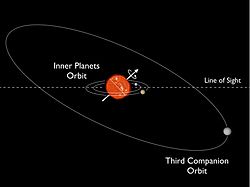Kepler-56
 Graphical sketch of the Kepler-56 system. The line of sight from Earth is illustrated by the dashed line, and dotted lines show the orbits of three detected companions in the system. The solid arrow marks the rotation axis of the host star, and the thin solid line marks the host star equator. Credit: NASA GSFC/Ames/D Huber | |
| Observation data Epoch J2000.0[1] Equinox J2000.0[1] | |
|---|---|
| Constellation | Cygnus |
| Right ascension | 19h 35m 02.0014s[5] |
| Declination | +41° 52′ 18.692″[5] |
| Apparent magnitude (V) | 13 |
| Characteristics | |
| Spectral type | G0V[citation needed] |
| Astrometry | |
| Proper motion (μ) | RA: −6.746±0.044[5] mas/yr Dec.: −12.025±0.043[5] mas/yr |
| Parallax (π) | 1.0673 ± 0.0280 mas[5] |
| Distance | 3,060 ± 80 ly (940 ± 20 pc) |
| Details | |
| Mass | 1.37 M☉ |
| Radius | 4.23 R☉ |
| Temperature | 4931 K |
| Other designations | |
| Database references | |
| SIMBAD | data |
Kepler-56 is a star roughly 3,060 light years away[5] with slightly more mass than the Sun. It has two confirmed planets, one slightly smaller than Neptune, and another slightly smaller than Saturn. Both planets were discovered in 2012.
Planetary system
In 2012, a planetary system was discovered around Kepler-56 via transit method. Planets were subsequently confirmed through transit timing variation method.
Asteroseismological studies revealed that the orbits of Kepler-56b and Kepler-56c are about 45° misaligned to the host star's equator. Follow-up radial velocity measurements revealed the evidence of a gravitational perturbator but currently it is not clear if it is a nearby star or a third planet.[6]
Both Kepler-56b and Kepler-56c will be devoured by their parent star in 130 and 155 million years, respectively.[7][8]
| Companion (in order from star) |
Mass | Semimajor axis (AU) |
Orbital period (days) |
Eccentricity | Inclination | Radius |
|---|---|---|---|---|---|---|
| b[2][9] | 0.07 MJ | 0.1028 | 10.5034294 | — | 79.640° | 3.606495320 R🜨 |
| c[3][10] | 0.569 MJ | 0.1652 | 21.4050484 | — | 81.930° | 7.844702558 R🜨 |
| d[4] | 3.3 MJ | 2 | — | 0.4 | — | — |
References
- ^ a b "Kepler-56". SIMBAD. Centre de données astronomiques de Strasbourg.
- ^ a b "Planet Kepler-56 b". The Extrasolar Planets Encyclopaedia. Retrieved 2013-10-18.
- ^ a b "Planet Kepler-56 c". The Extrasolar Planets Encyclopaedia.
- ^ a b "Planet Kepler-56 d". The Extrasolar Planets Encyclopaedia.
- ^ a b c d e f Brown, A. G. A.; et al. (Gaia collaboration) (August 2018). "Gaia Data Release 2: Summary of the contents and survey properties". Astronomy & Astrophysics. 616. A1. arXiv:1804.09365. Bibcode:2018A&A...616A...1G. doi:10.1051/0004-6361/201833051. Gaia Data Release 2 Vizier catalog entry
- ^ "Stellar Spin-Orbit Misalignment in a Multiplanet System". Science. 342 (6156): 331–334. 2013-10-21. arXiv:1310.4503. Bibcode:2013Sci...342..331H. doi:10.1126/science.1242066.
{{cite journal}}: Unknown parameter|authors=ignored (help) - ^ Miriam Kramer (10 June 2014). "Chow Down! Star Will Devour 2 Alien Planets". Space.com. Retrieved 11 June 2014.
- ^ Gongjie Li; Smadar Naoz; Francesca Valsecchi; John Asher Johnson; Frederic A. Rasio (2014). "The Dynamics of the Multi-planet System Orbiting Kepler-56". The Astrophysical Journal. 794 (2): 131. arXiv:1407.2249. Bibcode:2014ApJ...794..131L. doi:10.1088/0004-637X/794/2/131.
- ^ "KOI-1241.02 -- Extra-solar Confirmed Planet". SIMBAD.
- ^ "KOI-1241.01 -- Extra-solar Confirmed Planet". SIMBAD.



